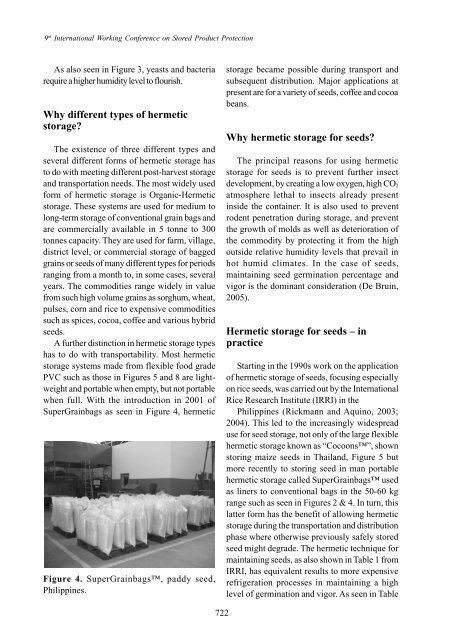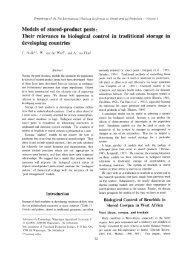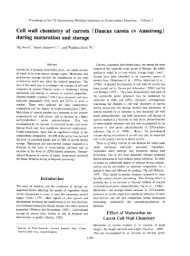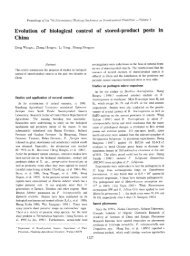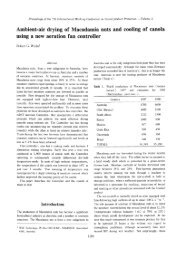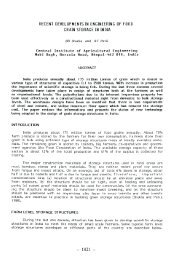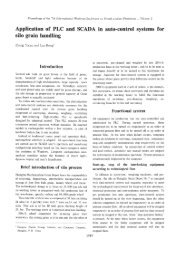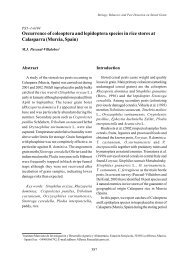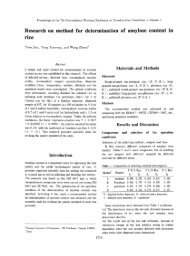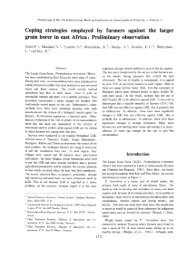Development and applications of the hermetic storage technology
Development and applications of the hermetic storage technology
Development and applications of the hermetic storage technology
You also want an ePaper? Increase the reach of your titles
YUMPU automatically turns print PDFs into web optimized ePapers that Google loves.
9 th International Working Conference on Stored Product Protection<br />
As also seen in Figure 3, yeasts <strong>and</strong> bacteria<br />
require a higher humidity level to flourish.<br />
Why different types <strong>of</strong> <strong>hermetic</strong><br />
<strong>storage</strong>?<br />
The existence <strong>of</strong> three different types <strong>and</strong><br />
several different forms <strong>of</strong> <strong>hermetic</strong> <strong>storage</strong> has<br />
to do with meeting different post-harvest <strong>storage</strong><br />
<strong>and</strong> transportation needs. The most widely used<br />
form <strong>of</strong> <strong>hermetic</strong> <strong>storage</strong> is Organic-Hermetic<br />
<strong>storage</strong>. These systems are used for medium to<br />
long-term <strong>storage</strong> <strong>of</strong> conventional grain bags <strong>and</strong><br />
are commercially available in 5 tonne to 300<br />
tonnes capacity. They are used for farm, village,<br />
district level, or commercial <strong>storage</strong> <strong>of</strong> bagged<br />
grains or seeds <strong>of</strong> many different types for periods<br />
ranging from a month to, in some cases, several<br />
years. The commodities range widely in value<br />
from such high volume grains as sorghum, wheat,<br />
pulses, corn <strong>and</strong> rice to expensive commodities<br />
such as spices, cocoa, c<strong>of</strong>fee <strong>and</strong> various hybrid<br />
seeds.<br />
A fur<strong>the</strong>r distinction in <strong>hermetic</strong> <strong>storage</strong> types<br />
has to do with transportability. Most <strong>hermetic</strong><br />
<strong>storage</strong> systems made from flexible food grade<br />
PVC such as those in Figures 5 <strong>and</strong> 8 are lightweight<br />
<strong>and</strong> portable when empty, but not portable<br />
when full. With <strong>the</strong> introduction in 2001 <strong>of</strong><br />
SuperGrainbags as seen in Figure 4, <strong>hermetic</strong><br />
Figure 4. SuperGrainbags, paddy seed,<br />
Philippines.<br />
722<br />
<strong>storage</strong> became possible during transport <strong>and</strong><br />
subsequent distribution. Major <strong>applications</strong> at<br />
present are for a variety <strong>of</strong> seeds, c<strong>of</strong>fee <strong>and</strong> cocoa<br />
beans.<br />
Why <strong>hermetic</strong> <strong>storage</strong> for seeds?<br />
The principal reasons for using <strong>hermetic</strong><br />
<strong>storage</strong> for seeds is to prevent fur<strong>the</strong>r insect<br />
development, by creating a low oxygen, high CO2<br />
atmosphere lethal to insects already present<br />
inside <strong>the</strong> container. It is also used to prevent<br />
rodent penetration during <strong>storage</strong>, <strong>and</strong> prevent<br />
<strong>the</strong> growth <strong>of</strong> molds as well as deterioration <strong>of</strong><br />
<strong>the</strong> commodity by protecting it from <strong>the</strong> high<br />
outside relative humidity levels that prevail in<br />
hot humid climates. In <strong>the</strong> case <strong>of</strong> seeds,<br />
maintaining seed germination percentage <strong>and</strong><br />
vigor is <strong>the</strong> dominant consideration (De Bruin,<br />
2005).<br />
Hermetic <strong>storage</strong> for seeds – in<br />
practice<br />
Starting in <strong>the</strong> 1990s work on <strong>the</strong> application<br />
<strong>of</strong> <strong>hermetic</strong> <strong>storage</strong> <strong>of</strong> seeds, focusing especially<br />
on rice seeds, was carried out by <strong>the</strong> International<br />
Rice Research Institute (IRRI) in <strong>the</strong><br />
Philippines (Rickmann <strong>and</strong> Aquino, 2003;<br />
2004). This led to <strong>the</strong> increasingly widespread<br />
use for seed <strong>storage</strong>, not only <strong>of</strong> <strong>the</strong> large flexible<br />
<strong>hermetic</strong> <strong>storage</strong> known as “Cocoons”, shown<br />
storing maize seeds in Thail<strong>and</strong>, Figure 5 but<br />
more recently to storing seed in man portable<br />
<strong>hermetic</strong> <strong>storage</strong> called SuperGrainbags used<br />
as liners to conventional bags in <strong>the</strong> 50-60 kg<br />
range such as seen in Figures 2 & 4. In turn, this<br />
latter form has <strong>the</strong> benefit <strong>of</strong> allowing <strong>hermetic</strong><br />
<strong>storage</strong> during <strong>the</strong> transportation <strong>and</strong> distribution<br />
phase where o<strong>the</strong>rwise previously safely stored<br />
seed might degrade. The <strong>hermetic</strong> technique for<br />
maintaining seeds, as also shown in Table 1 from<br />
IRRI, has equivalent results to more expensive<br />
refrigeration processes in maintaining a high<br />
level <strong>of</strong> germination <strong>and</strong> vigor. As seen in Table


